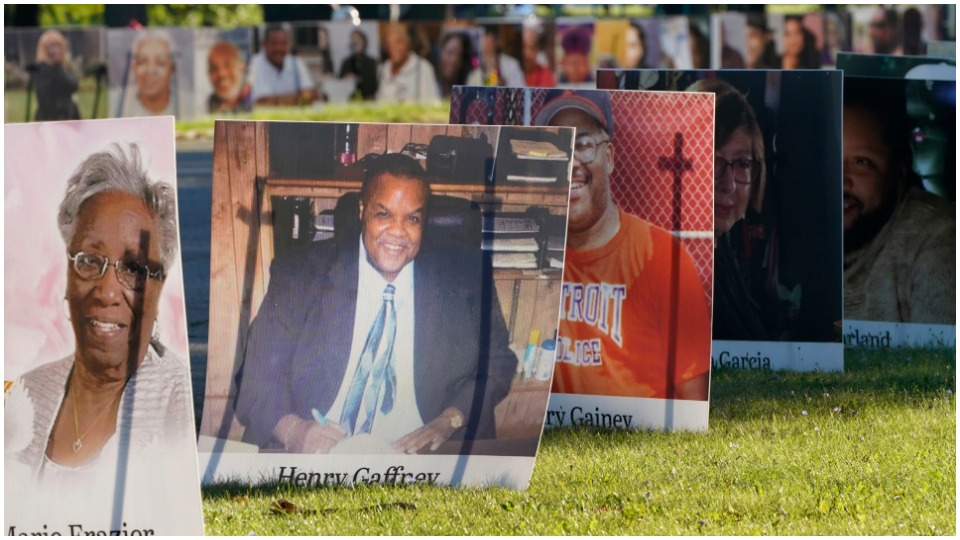
It wasn’t so long ago, just back in May, that the United States reached the gruesome milestone of 100,000 dead of COVID-19, setting a world record for the number of deaths. Two months later, in late July, we reached 150,000, still holding onto the Number 1 place as the world’s epicenter for the killer disease. And now, mid-September, we are at the 200,000 mark, bearing down fast on a quarter of a million probably just around Election Day. More world records.
No wonder these numbers have no place in Donald Trump’s re-election playbook. His defenders speak of the pandemic only in the past tense—what a terrific job the president did in bringing it under control!

We know from the journalist Bob Woodward’s tape-recorded conversations with Trump that the president purposely withheld the severity of the coronavirus from the American public in the empty hope that it might just “disappear” in time to be forgotten by November. The perennial weekend golfer was clearly incapable of coping with a national challenge of this magnitude. Carl Bernstein, Woodward’s former writing partner going back to the Nixon Watergate scandal times, calls Trump’s behavior “a kind of homicidal negligence.”
Statistics are vital to track. But behind these morbid numbers lie the corpses of unique, individual women and men, and yes, even some youngsters now, who had families, spouses, children, and grandchildren. People they worked with, prayed with, sang and danced with, attended weddings and sports events with, shared barbecues with, and argued with over films and politics.
Now their lives are snuffed out, not so much from a virus—because other countries, far less prosperous and advanced than the U.S., stepped up to contain it so much better—but from unpreparedness, lack of will, lack of effective response, abdication of executive duty, failure to follow the science, corporate greed, and cynical political calculation. And underlying it all, from the fatal weaknesses in the chaotic, punitive American health care system which values profit for the few over the protective mantle of universal health care for all.
In the latest iteration of White House policy, Trump appears to be favoring the “herd immunity” approach which allows the pandemic to run its course, killing off thousands, maybe hundreds of thousands of more people along the way, in the frail expectation that those left will have achieved immunity from so many recovered cases. His new advisor, Dr. Scott Atlas, believes this. According to such a model, there’s no point to testing. If you get sick, you’ll either die (no more Social Security payments!) or recover, even if you have long-term residual complications.
According to a Sept. 2 Los Angeles Times editorial, “Undergirding a herd immunity strategy is the morally reprehensible notion that older people and those with chronic conditions such as diabetes and obesity (conditions that affect a significant number of Americans) are expendable because they would die soon anyhow. That’s an idea that has no place in a civilized society.”
In other countries, the mismanagement of a pandemic on this level of incompetency would be met with severe punishment, removal from office, and perhaps jail. One can only hope that the American people will make their judgment of the Trump regime forcefully known on November 3 and that the country can right itself on a rational course toward beating this health crisis so that we can start the work of rebuilding.
People living in the United States have but fleetingly, as an insincere afterthought, heard from the Executive Office a word of comfort, solidarity, and empathy with the suffering families whose breadwinner has been ripped away, whose grandparent has been taken too soon, whose mom or dad will no longer be there to hug and hold. Even in tragedy, we expect our president to stand in mourning and in hope with us, but in this con man/politician’s eyes, even the slightest gesture of sympathy would only be interpreted as an abject admission of failure. Perhaps it’s that callousness, as much as the monstrous losses his policies have inflicted, that has hit such a deep place of anger in the nation’s heart.
And from other angles…
In our previous sad commemorations of these milestones, we ticked off the names of whole cities with a population of 100,000 or 150,000 that those “statistics” would have wiped off the map, every last woman, man, and child gone forever.
Now that we’re at 200,000, let’s look at this number from a couple of different angles. There are nearly 200 countries in the world today. In population, China is the largest, with approximately 1,434,000,000 people, followed by India, with 1,367,000,000. Third largest, but far behind those numbers, is the United States at 330,000,000. Yet China managed to successfully bring COVID-19 under quick control with strict universal measures that still kept people in their homes, well-fed and cared for. Still vigilant about any new eruption of the virus, China deals with it locally and efficiently to keep it from spreading. China’s total number of deaths is reported at 4,724, approximately 2.5% of the U.S. number, with over four times the U.S. population. India, a poor country with over a billion more inhabitants than the U.S., has recorded up to this writing only 66,333 coronavirus deaths. [Sourced from Johns Hopkins University Coronavirus Resource Center.]
Suppose we looked at the world’s nations at the lower end of the population rankings. Which whole countries—apart from some remaining small dependencies such as the Falkland Islands (UK) or St. Pierre and Miquelon (France) or American Samoa (U.S.)—would now have been completely killed off had 200,000 deaths come their way? The following are 2019 numbers:
Vatican City (801) gone. Nauru (10,756) gone. Also Tuvalu (11,646), Palau (18,008), San Marino (33,860), Liechtenstein (38,019), Monaco (38,964), St. Kitts and Nevis (52,823), Greenland (56,672—still owned by Denmark, but too significant a landmass to ignore).
Disappeared, too, would be the whole populations of the Marshall Islands (58,791), Bermuda (62,506, also still a UK possession), Dominica (71,808), Andorra (77,142), Antigua and Barbuda (97,118), Seychelles (97,739), U.S. Virgin Islands (104,578), Aruba (106,314—owned by the Netherlands), St. Vincent and the Grenadines (110,589), Tonga (110,940), Grenada (112,003), Federated States of Micronesia (113,815), Kiribati (117,606), Curaçao (163,424, also still Dutch-owned), Guam (167,294, owned by the U.S.), the UK Channel Islands (172,259), St. Lucia (182,790), and Western Samoa (197,097). [Sourced from the United Nations on Wikipedia.]
These places may be small in population, but each one of them is rich in languages, cultures, cuisine, history, and traditions. If the decimation of 200,000 dead spread across the United States is a stunningly tragic and unnecessary blow, imagine if you were from one of these smaller nations or territories whose entire population had vanished like some modern-day Atlantis.

Do you live in one of these counties?
Now let’s look at this staggering statistic in another way. Most U.S. states are divided into counties. Texas has the most, with 254, and Delaware has the fewest, with three. There are a few states where county government is weak or nonexistent and where municipalities are the regional authorities, and Louisiana, of course, dating back to its Catholic past, has “parishes.” But most people have some legal, political, social, and emotional tie to the county they live in or come from apart from the city or township where they live.
In population, Los Angeles County is by far the largest in the U.S., with over 10 million residents. But county names do not always reflect the name of the principal city or township in the district. L.A. County, for example, actually includes 88 separate municipal jurisdictions, including such well-known cities as Long Beach, Santa Monica, Beverly Hills, and Pasadena, among others. In the chart below [sourced from Wikipedia] we only provide the county name, not the primary cities located in them, so if you are interested to learn more you have only to do a quick internet search for more details.
Below are more than 100 counties in the United States with populations ranging from our last milestone of 150,000 to the new figure of 200,000. Keep in mind, of course, there are many times this many counties that have fewer residents. The entire populations of these counties would be dead from the coronavirus if all 200,000 were concentrated there. How else to convey the scale of these losses? Maybe these numbers will resonate with you, reader, if you happen to recognize yourself in these places. We do all we can not to become stupefied—numbed—by numbers. A vast majority of these deaths could have been prevented with a pandemic preparation plan in place and with a rapid, organized, and scientifically guided response once it hit.
We are angry. We are outraged. We are offended by the gross negligence of our nation’s leaders. And we mourn those we have lost and will never see and touch and embrace again. We extend our solidarity to all those who have lost friends, family, and co-workers to COVID-19. Our voices rise in protest and we will—we must—be heard. As you survey the following roster of counties across our great nation, you will undoubtedly recall places you’ve visited, homes where friends and relatives live, somewhere you once planted roots, perhaps. And you will think of how we will survive this plague somehow and start to heal ourselves and our ailing nation.
U.S. County Populations up to 200,000 |
|||
| State, County | Population | State, County | Population |
| New Mexico, Santa Fe | 150,358 | Ohio, Greene | 168,937 |
| Michigan, Monroe | 150,500 | North Carolina, Alamance | 169,509 |
| Connecticut, Tolland | 150,721 | Wisconsin, Kenosha | 169,561 |
| Maryland, Washington | 151,049 | Pennsylvania, Monroe | 170,271 |
| Iowa, Johnson | 151,140 | Indiana, Hendricks | 170,311 |
| New Hampshire, Merrimack | 151,391 | Indiana, Porter | 170,389 |
| Maine, Penobscot | 152,148 | South Carolina, Aiken | 170,872 |
| Virginia, Stafford | 152,882 | Illinois, McLean | 171,517 |
| California, Kings | 152,940 | Wisconsin, Winnebago | 171,907 |
| Georgia, Bibbs | 153,159 | Iowa, Scott | 172,943 |
| Louisiana, Ouachita Parish | 153,279 | Michigan, Muskegon | 173,566 |
| Michigan, Berrien | 153,401 | Florida, Bay | 174,705 |
| Colorado, Mesa | 154,210 | Texas, Johnson | 175,817 |
| Pennsylvania, Franklin | 155,027 | Puerto Rico, Carolina Municipality | 176,762 |
| Mississippi, Rankin | 155,271 | Texas, Midland | 176,832 |
| New York, Schenectady | 155,299 | Ohio, Licking | 176,862 |
| Texas, Comal | 156,209 | Kansas, Shawnee | 176,875 |
| Georgia, Columbia | 156,714 | Utah, Washington | 177,556 |
| California, Madera | 157,327 | New York, Ulster | 177,573 |
| Ohio, Fairfield | 157,574 | West Virginia, Kanawha | 178,124 |
| Georgia, Houston | 157,863 | Illinois, Peoria | 179,179 |
| Indiana, Johnson | 158,167 | Virginia, City of Newport News | 179,225 |
| Minnesota, Olmsted | 158,293 | Ohio, Medina | 179,746 |
| Tennessee, Sullivan | 158,348 | California, Shasta | 180,080 |
| Michigan, Jackson | 158,510 | Connecticut, Litchfield | 180,333 |
| New York, Rensselaer | 158,714 | Missouri, Boone | 180,463 |
| Michigan, St. Clair | 159,128 | North Carolina, Pitt | 180,742 |
| Virginia, City of Alexandria | 159,428 | Delaware, Kent | 180,786 |
| North Carolina, Catawba | 159,551 | California, Imperial | 181,215 |
| Florida, Indian River | 159,923 | Indiana, Vanderburgh | 181,451 |
| Massachusetts, Hampshire | 160,830 | North Carolina, Iredell | 181,806 |
| Florida, Martin | 161,000 | North Dakota, Cass | 181,923 |
| Minnesota, Stearns | 161,075 | Florida, Santa Rosa | 184,313 |
| Montana, Yellowstone | 161,300 | Texas, Ellis | 184,826 |
| Pennsylvania, Centre | 162,385 | Mississippi, DeSoto | 190,539,945 |
| Connecticut, Middlesex | 162,436 | Nebraska, Sarpy | 187,196 |
| Ohio, Portage | 162,466 | Pennsylvania, Butler | 187,853 |
| Guam, Guam | 162,742 | Wisconsin, Outagamie | 187,885 |
| South Carolina, Dorchester | 162,809 | Florida, Charlotte | 188,910 |
| Maryland, Charles | 163,257 | New York, Broome | 190,488 |
| Wisconsin, Rock | 163,354 | Michigan, Saginaw | 190,539 |
| Vermont, Chittenden | 163,774 | Tennessee, Sumner | 191,283 |
| Pennsylvania, Beaver | 163,929 | Michigan, Livingston | 191,995 |
| Rhode Island, Kent | 164,292 | South Carolina, Beaufort | 192,122 |
| Alabama, Lee | 164,542 | California, El Dorado | 192,843 |
| Kansas, Wyandotte | 165,429 | South Dakota, Minnehaha | 193,134 |
| Idaho, Kootenai | 165,697 | Florida, Hernando | 193,920 |
| Texas, Ector | 166,223 | Illinois, Sangamon | 194,672 |
| Puerto Rico, Ponce Municipality | 166,327 | Indiana, Tippecanoe | 195,732 |
| Texas, Guadalupe | 166,847 | Georgia, Muscogee | 195,769 |
| Kentucky, Kenton | 166,998 | Wisconsin, Racine | 196,311 |
| Hawaii, Maui | 167,417 | Oregon, Deschutes | 197,692 |
| North Carolina, Davidson | 167,609 | North Carolina, Onslow | 197,692 |
| Colorado, Pueblo | 168,424 | Ohio, Trumbull | 197,974 |
| Maryland, Carroll | 168,447 | Minnesota, St. Louis | 199,070 |
| Georgia, Paulding | 168,667 | ||
Chloe Caldasso formatted the above table.
ELECTION 2020: Everything you need to know to vote in your state
Like free stuff? So do we. Here at People’s World, we believe strongly in the mission of keeping the labor and democratic movements informed so they are prepared for the struggle. But we need your help. While our content is free for readers (something we are proud of) it takes money — a lot of it — to produce and cover the stories you see in our pages. Only you, our readers and supporters, can keep us going. Only you can make sure we keep the news that matters free of paywalls and advertisements. If you enjoy reading People’s World and the stories we bring you, support our work by becoming a $5 monthly sustainer today.












Comments